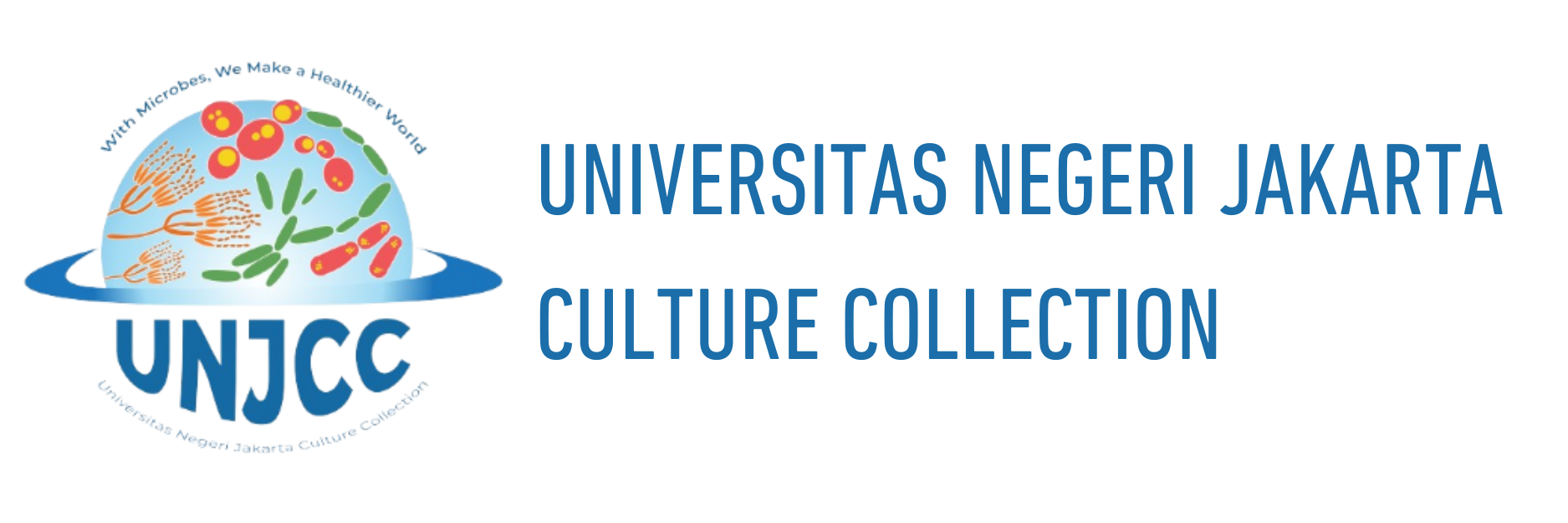OUR PUBLISHED RESEARCH
Step into the realm of discovery with our collection of published research. UNJCC actively conducts research, particularly in the field of microbiology, and has been actively publishing numerous research articles since 2016.
Screening the capabilities of Indonesian indigenous mold in producing cellulase enzyme
This study aims to get the isolates of mold that can potentially produce cellulase enzyme. This research was conducted in December 2017 until January 2018 in Microbiology Laboratory of Universitas Negeri Jakarta. The screening test of potential isolates producing cellulase enzymes was performed on 31 isolates of UNJCC in CDA medium with addition of Carboxymethyl Cellulose (CMC) substrate and testing of clear zone formation using 0.1% congo red reagent. From the result of the research, there are 18 potential mold isolates which can produce cellulase enzyme. 3 isolates which have the highest Cellulolytic index are isolate A17, K4, and 1 which have cellulolytic index value of 1.03, 0.32, 0.29. From macroscopic and microscopic identification it can be assumed that the coded isolates of K4 and A17 belong to the genus Aspergillus, while, isolates code 1 belong to the genus Penicillium. Forming the clear zone on CMC subtrate with dropped congo red reagent it because congo red reagent can bind strongly with polysaccharides containing β (1-4) D-glucopyranosyl bonds. And the ability of clear zone formation on CMC substrates shows the presence of enzyme endo-β-1,4 glucanase (CMCase) that can breaks off the β -1,4-glycosidic bond linking D-glucose monomer to CMC.
Read more >> DOI: 10.1088/1757-899X/434/1/012125
Isolation and characterization of aflatoxigenic Aspergillus spp. from maize of livestock feed from Bogor
IOP Conference Series: Materials Science and Engineering, 2018.
Read more >> DOI: 10.1088/1757-899X/434/1/012105
Recent Advancement in White Biotechnology Through Fungi: 65-99, 2019.
Fungal Phytases: Biotechnological Applications in Food and Feed Industries
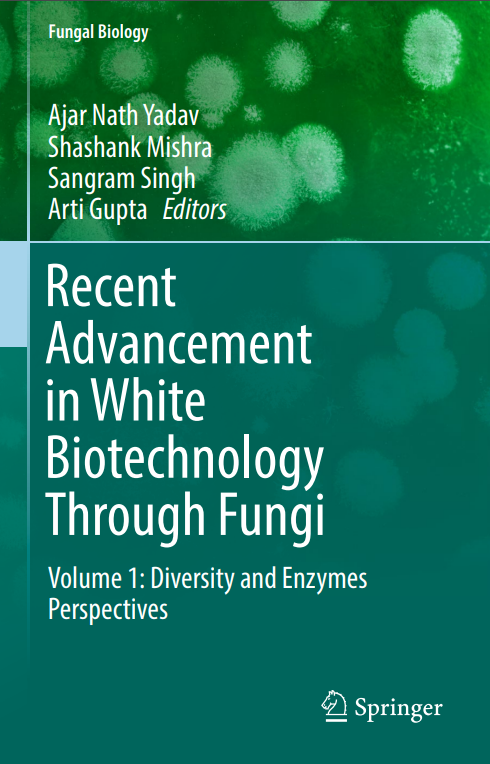
Read more >> DOI: 10.1007/978-3-030-14846-1_2
Screening and characterization of amylolitic mold originated from ghost crab (Ocypode sp.) in Cidaon, Ujung Kulon National Park, Indonesia
AIP Conference Proceedings, 2019.
Read more >> DOI: 10.1063/1.5115725
Potential amylase-producing yeast isolated from indigenous fermented beverages originating from Bali, Indonesia
Journal of Physics: Conference Series, 2019.
Indonesia has many fermented beverages, and yeast become one of the agents in fermented process. Yeasts has a role to transform carbohydrate complex into simple compounds with release secondary metabolism to environment like amylase enzyme. This study aims to get the isolate of yeast that can potentially produce amylase enzyme. This research conducted in October 2018 until March 2019 in Microbiology Laboratory of Universitas Negeri Jakarta. The screening test of potential isolate producing amylase enzyme was performed on yeast isolate from eight source of indigenous fermented beverages that can grow in YMA medium with pH 2. Screening was carried out on YPSA medium with diffusion agar method. From 50 Isolates, 16 isolates with the codes IB4, IB15, IB20, IB21, IB26, IB36, IL78, IL80, IL81, IL86, IL88, IL97, IL113, IL136, IL146, and IL150, were able to form clear zone after 1-day incubation in room temperature. The highest amylolytic index was produced by IL86 (1,019 mm). Forming the clear zone is proof that yeast can transform starch become simpler sugar like maltose as iodine-starch reaction is resulting amylose helix and iodine become I3− that filled main core helix. In addition to this, iodine forms complexes with starch molecules showed a dark purple
Read more >> DOI: 10.1088/1742-6596/1402/5/055021
Antagonistic activity of phylloplane yeasts from Moringa oleifera Lam. leaves against Aspergillus flavus UNJCC F-30 from chicken feed

Aspergillus flavus is widely known as an aflatoxin-producing fungus that frequently contaminates feed and affects livestock, which leads to severe health problem for animal and human. Biological agents have been proven to prevent this contamination since they can produce metabolites which have antagonistic activity. In this study, phylloplane yeasts isolated from Moringa oleifera leaf have shown an ability to inhibit the growth of Aspergillus flavus UNJCC F-30 collected from chicken feed. This research was conducted in three stages: (1) yeast isolation (leaf washing and direct method), followed by (2) antagonistic test using dual culture method, and (3) molecular identification using D1/D2 region of 26S rDNA. In the first stage, 38 yeast isolates have been succesfully obtained. These isolates were of different colors: peach pigment (60.5%), the non-pigmented yeast (26.5%), cream (10%), and orange (3%). Antagonistic activity against A. flavus UNJCC F-30 was tested based on growth, sporulation, and the presence of clear zones. Screening result showed that 12 yeast isolates are capable of inhibiting A. flavus UNJCC F-30. Among them, 4 isolates with the code K4, K10, K15, and K26 showed the highest antagonist ability. Molecular identification resulted that the 4 isolates show a similar identity with Aureobasidium pullulans UWFP 993 (100%), Aureobasidium melanogenum QCC:M017/17 (99%), Aureobasidium melanogenum QCC:M017/17 (100%) and Rhodotorula taiwanensis CBS:11729 (99%), respectively. Isolate K10 exhibited the highest percentage of inhibition activity among all isolates which is potential for application as biocontrol agent against A. flavus. As A. pullulans is a common yeast found on leaf surfaces of many Indonesian flora, therefore it can be considered as safe and alternative to reduce fungal contamination from A. flavus in feed chicken.
Read more >> DOI: 10.1007/s42360-020-00194-2
Chicken drumstick mushroom (Coprinus comatus) ethanol extract exerts a hypoglycaemic effect in the Rattus norvegicus model of diabetes
We assayed the effect of a C. comatus ethanol extract on the blood glucose, glycosylated haemoglobin, superoxide dismutase, and plasma insulin levels of male Wistar rats (Rattus norvegicus) with alloxan-induced DM, and performed a dose-response analysis. This study used a completely randomised design and a post-test approach, and included a control group.
The C. comatus ethanol extract reduced the blood glucose, MDA, and HbA1c levels and increased the plasma insulin level. The 500 mg/kg body weight dose exhibited the greatest efficacy, as it reduced the blood glucose level by 12.33%, HbA1c level by 6.35%, MDA level by 32.6%, and SOD and plasma insulin levels by 10.57%.
Read more >> DOI: 10.1016/j.bcab.2019.101050
Isolation and screening of amylolytic yeast from Paphiopedilum sp., originating from Bedugul Botanical Garden, Bali, Indonesia
Read more >> DOI: 10.1088/1742-6596/1402/3/033060
Antifungal Mechanism of Rhodotorula mucilaginosa and Aureobasidium sp. nov. Isolated from Cerbera manghas L. against the Growth of Destructive Molds in Post Harvested Apples
Recent Patents on Food, Nutrition & Agriculture, 2020.
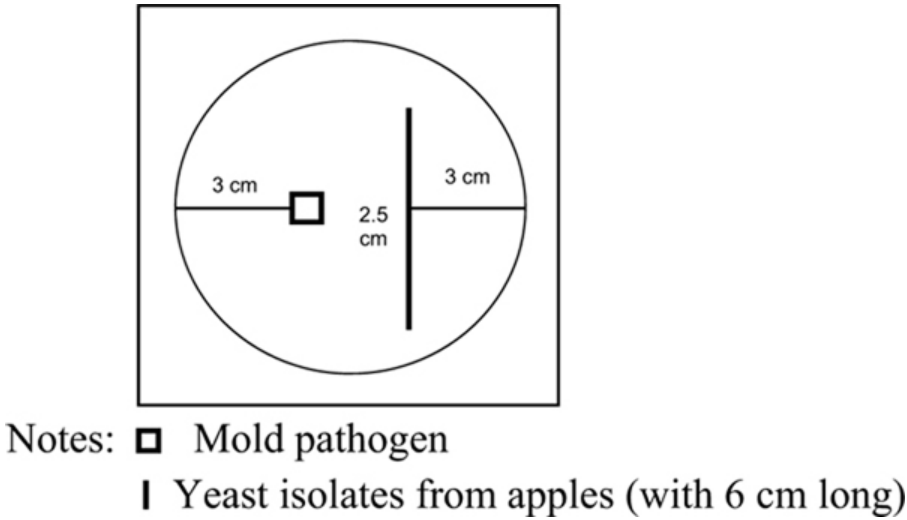
Objective: The aim of this study is to screen potential yeast, which has the ability to inhibit the growth of Aspergillus brasielensis (isolate A1) and Aspergillus flavus section flavi (isolate A17) isolated from apple fruits.
Methods: Antagonism test using YMA dual culture medium using in vitro assays and ITS rDNA identification were performed.
Results: The result showed that 3 out of 19 yeast isolated from Cerbera manghas L, T1, T3 and T4, demonstrated the potential ability as a biocontrol agent. ITS rDNA identification demonstrated that T1 has a similarity to Rhodotorula mucilaginosa while T3 and T4 were identified as Aureobasidium sp. nov. The 3 isolates exhibited the ability to reduce the growth of A. brasiliensis sensu lato better than dithane 0.3% with a Disease Incidence (DI) of 100% and a Disease Severity (DS) value of 45%. Only isolate T1 and T3 were able to reduce decay symptoms in apples inoculated with A. flavus sensu lato (with DO and DS were 100% and 25%, respectively) compared to dithane pesticides 0.3%.
Conclusion: This study indicated that competition between nutrients occurs between pathogenic molds and under-yeast in vitro and in vivo conditions. However, further studies in the future might be able to elucidate the ‘killer’ activity and interaction with the pathogen cells and the bio-product production using Rhodotorula mucilaginosa and Aureoubasidium namibiae strains to control postharvest diseases.
Screening of amylolytic and cellulolytic yeast from Dendrobium spathilingue in Bali Botanical Garden, Indonesia
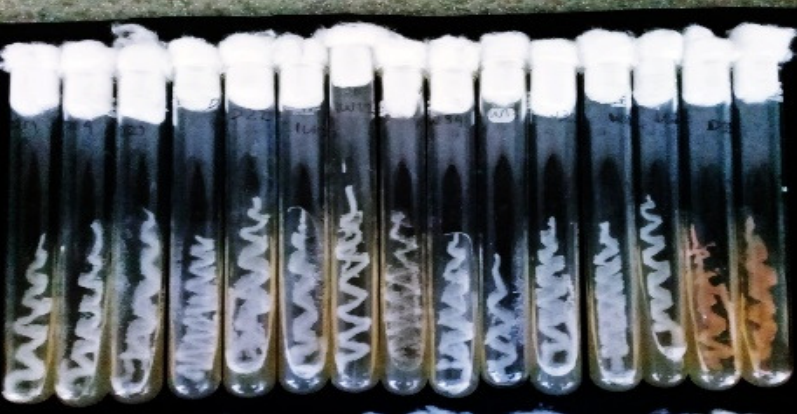
Read more >> DOI: 10.1063/5.0007802
Metagenomic-based approach for the analysis of yeast diversity associated with amylase production in Lai (Durio kutejensis)
This study reported the application of a next generation sequencing (NGS) analysis of yeast diversity in native Indonesian fruit, Durio kutejensis, collected from Borneo, Central Kalimantan. The analysis was designed to observe the microbial consortium associated with solid state fermentation (SSF) for amylase production. Together with the additional data from culture-dependent analysis, we observed the morphological features, molecular characteristics, and amylase concentration produced by each isolate. We performed Solid State Fermentation (SSF) for amylase production and the enzyme activity was then determined using UV-Vis spectrophotometer at 540 nm. Result obtained from metagenomic approach consist of 4 group that fungal species included in the Ascomycota identified as Botryosphaeria dothidea (1.35%), Lasiodiplodia crassispora(17.62%), Aureobasidium pullulans (55.02%), Paraphoma chrysanthemicola (11.38%), Preussia funiculate (1.90%), Sporormiella intermedia (0.82%), Myrothecium gramineum (1.35%), Fusarium oxysporum (6.24%), Fusarium proliferatum (3.25%) and Phialemoniopsis curvata (1.08%). The results of isolation using culturable medium in the form of YMA obtained 40 yeast isolates. A total of 40 representative isolates from durian fruit were screened, two positive amylase isolates based on clear zones formed were DU 4.2 (Candida sorboxylosa) and DU4.22 (Cyberlindnera fabianii) isolates with amylolytic index of DU 4.2 isolates at 0.24 and DU 4.22 at 0.72 with an incubation time of 48 h. The highest amylase enzyme activity was found in isolate DU 4.2 of 31.21 U/mL.
Read more >> DOI: 10.22207/JPAM.15.1.02
Antagonist Test of Endophyte Fungi Isolated from Leaves of Mangrove (Rhizophora sp.) as Antifungi Against Sanca Snakes (Malayopython sp.) Disease
Mangrove plants have many benefits, such as the ability to produce bioactive compounds. Bioactive compounds can be produced by endophytic fungi found on mangrove leaves. Endophytic fungi are also known to produce secondary metabolites that are the same as their hosts produce for plant defense. Endophytic fungi in mangrove leaves (Rhizophora sp.) have antagonistic potential against pathogenic fungi. One of the pathogenic fungi was shown to cause a skin disease in pythons (Malayopython sp.) through the transmission via tick saliva. Pathogenic fungi found in tick saliva were Fusarium oxysporum and Aspergillus niger. This study examined the potential of endophytic fungi in mangrove leaves (Rhizophora sp.) as anti-fungal pathogens in pythons. Endophytic fungi were isolated from mangrove leaves at the Angke Kapuk Mangrove Nature Park, Pantai Indah Kapuk, DKI Jakarta, and an antagonist test of endophytic fungi against pathogenic fungi was performed using the dual culture assay method. This study obtained 16 isolates, and nine isolates had antagonistic potential. These nine isolates produced a clear zone in the antagonist test. The inhibition zone indicates endophytic fungi inhibit the growth of pathogenic fungi.
Read more >> DOI: 10.55003/cast.2023.258187
FORKOMIKRO: Catalogue of Microorganisms

Read more >> DOI: 10.55981/brin.508
The Potential of Cellulolytic Yeast Pichia manshurica UNJCC Y-123, Saccharomyces cerevisiae UNCC Y-84, and Saccharomyces cerevisiae UNJCC Y-83 to Produce Cellulase Enzyme by Using Substrate Skin Delignification of Cocoa (Theobroma cocoa)
Trends in Science, 2023.
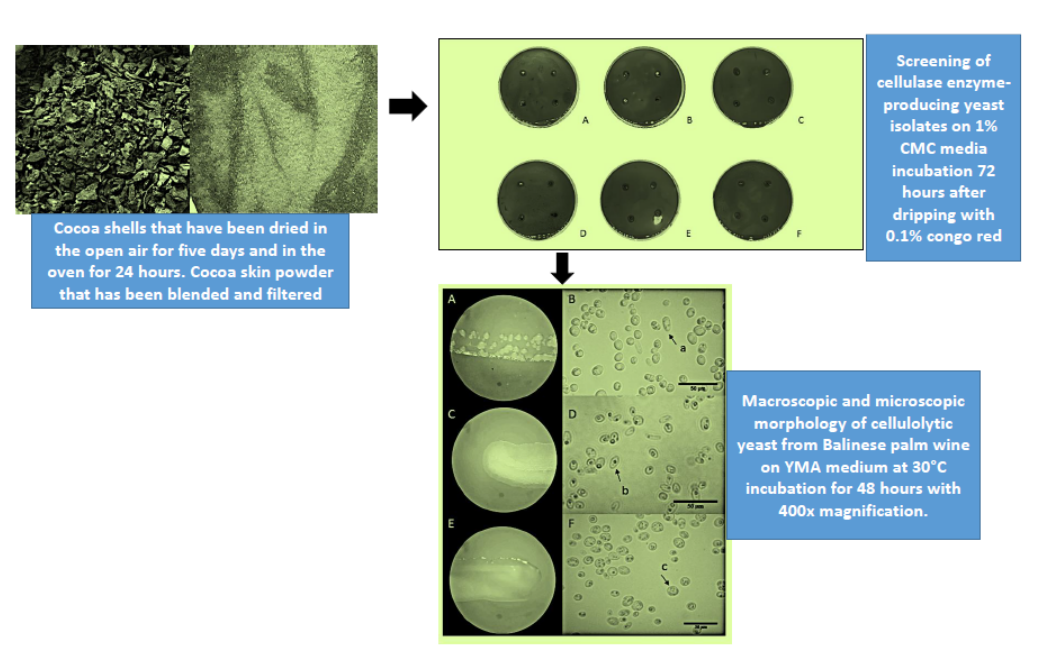
Read more >> DOI: 10.48048/tis.2023.6950
